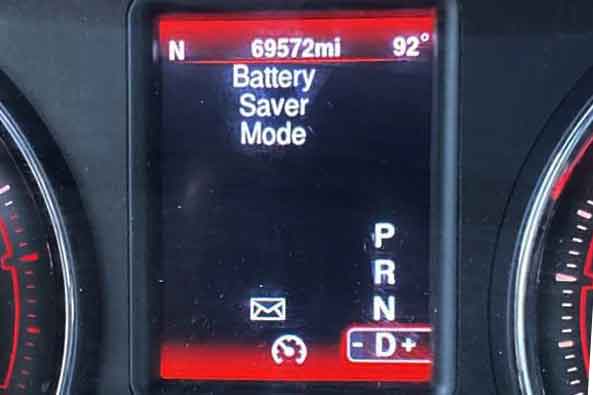Battery-saver mode is a feature in many modern vehicles, including the Dodge Charger, designed to conserve the battery’s power and extend its life. This feature is especially useful for those who frequently use their vehicle for short trips or have a lot of accessories that drain the battery. Suppose you get the message “Battery Saver Mode” on your dashboard. In that case, there may have been some issues, such as low battery voltage, alternator failure, overloaded electrical system, accessory drain, software error, etc.
Let’s dig into the details of your query “Battery Saver Mode Dodge Charger Warning” below and find out precisely what you should do now!
Contents
What Is Battery Saver Mode?
Battery saving mode is a feature on various automobiles, notably the Dodge Charger, that is designed to save battery power. When activated, the feature can limit or turn off specific electrical systems and accessories to reduce the drain on the battery. This can include things like the radio, interior lights, power windows, and air conditioning.
The goal of battery saver mode is to extend the battery’s life by conserving power when it is needed most, such as when the battery is low or the vehicle is not running. In some cases, the battery-saver mode may also reduce the vehicle’s power output to conserve battery power. The vehicle’s performance may be affected when the battery-saver mode is activated and should only be used when necessary.

What Causes Battery Saver Mode Dodge Charger? – Error Explained!
The “battery saver mode” message on the dashboard of your Dodge Charger may appear for a variety of reasons, including:
Low Battery Voltage:
The battery-saver mode is designed to kick in when the battery’s voltage drops below a certain threshold. This feature is activated to conserve power and prevent the battery from completely draining, which could result in the vehicle not starting. Low battery voltage can occur due to various factors, such as leaving the lights on for an extended period, a faulty battery, or a problem with the charging system.
Alternator Failure:
The alternator plays a crucial role in keeping the battery charged while the engine is running. It generates electricity that powers the vehicle’s electrical systems and simultaneously charges the battery. If the alternator fails to function properly, the battery may not receive a sufficient charge, leading to low voltage and triggering the battery saver mode.
Overloaded Electrical System:
The electrical system of a vehicle has a certain capacity to handle power consumption. If there are excessive demands on the electrical system, such as running multiple accessories simultaneously or leaving lights on for an extended period while the engine is off, the battery saver mode may act to prevent the battery from being drained excessively. This is a protective measure to preserve battery life and ensure that there is enough power to start the vehicle.
Accessory Drain:
Some accessories in the vehicle, such as power outlets, infotainment systems, or aftermarket installations, may continue to draw power even when the vehicle is turned off. If these accessories are not functioning correctly or are wired incorrectly, they can drain the battery over time. The battery saver mode can detect this excessive drain and activate it to prevent battery depletion.
Software Error:
Occasionally, the battery-saver mode message may appear due to a software error or glitch in the vehicle’s computer system. This could be caused by outdated software or a bug in the system. In such cases, updating the vehicle’s software or visiting a service center may be necessary to resolve the issue.
How Do You Fix the Battery Saver Mode on Dodge Charger?
Are you worried about how to turn off battery saver mode on the Dodge Charger? If the warning message appears on the dashboard of your vehicle, there are a few things you can do to address the issue:
1. Check the Battery
First, check the battery voltage with a multimeter. The battery is in good condition if the reading is 12.6 volts or above. The battery is considered dead if the reading is 12.4 volts or below.
If the battery is dead, you must replace it with a new one to fix this issue. And if the battery voltage seems okay, then there’s corrosion on the terminals. It can prevent the battery from charging and indicate that it is dead. Ensure the battery is connected correctly and there are no loose terminals or corroded connections. It may solve the issue.
If the engine struggles after starting the car or doesn’t start at all, the battery may be dead.
2. Check the Alternator
While the car is running, the alternator is in charge of keeping the battery charged. If the alternator is not working correctly, the battery will not be adequately charged, and the battery saver mode message may appear.
Here are a few steps to determine if the alternator is causing a low battery voltage:
- Check the alternator belt: If the alternator belt is loose or broken, it will prevent the alternator from charging the battery. Check the belt for wear, looseness, or cracks, and replace it if necessary.
- Monitor the battery voltage while the engine is running: With the engine running, check the battery voltage with a multimeter. If the voltage reading exceeds 13.5 volts, the alternator will likely function correctly. The alternator may only work properly if the voltage reading is above 13.5 volts.
- Check for warning lights: If the alternator is not functioning correctly, it may trigger warning lights on your dashboard, such as the battery or check engine light.
- Use a battery and alternator tester: This is a specialized tool that can test both the battery and alternator at the same time. It can provide a more accurate and comprehensive diagnosis of any issues.
If you detect that the alternator is faulty, then simply replace it. The issue should be solved.
3. Check the Vehicle’s Electrical System
If the headlights dim when you turn on other electrical devices, such as the A/C or the radio, it can indicate that the electrical system is overloaded. Ensure all lights and accessories are turned off, and the vehicle’s electrical system is not overloaded. This can cause the battery-saver mode to activate.
How Does Battery-Saver Mode Affect Vehicle Performance?
When the battery-saver mode is activated on a Dodge Charger, it can affect the vehicle’s performance in a few ways:
- Reduces Power Output: In battery-saver mode, the vehicle’s power output may be reduced to conserve battery power. This can result in a decrease in acceleration and overall performance.
- Changes to Lighting and Accessories: Some lighting and accessories may be turned off or limited to conserve battery power. This can include the interior lights, radio, and power windows.
- Possible Limitations on Vehicle Functions: Some functions may be limited or turned off when the battery-saver mode is activated. This can include air conditioning, power steering, and the ability to charge devices through USB ports.
- Reduces Fuel Economy: When the battery saver mode is activated, it could also reduce the fuel economy of the vehicle because of the reduction of power output.
- Reduces Safety Feature: Some safety features like power steering and brakes may be deactivated when the battery-saver mode is activated. This can make the vehicle harder to control, especially at low speeds or tight turns.

How Do You Maximize the Advantages of Battery-Saving Mode?
Here are some suggestions for maximizing the benefits of battery-saver mode on a Dodge Charger:
- Use the Feature Judiciously: Only activate battery saver mode when it is necessary to conserve battery power. Avoid using it as a regular driving mode.
- Check Your Battery Regularly: Make sure the battery is in good condition and is properly charged. A healthy battery will last longer and require less use of the battery-saver mode.
- Limit the Use of Accessories: When possible, turn off accessories like the radio, interior lights, and power windows to conserve battery power.
- Reduce Short Trips: Short trips can cause the battery to be drained quickly. Try to combine errands or take longer trips to help conserve battery power.
- Keep the Alternator in Good Working Condition: The alternator helps keep the battery charged while the vehicle is running. Ensure it is in good working condition to help reduce the need for battery-saver mode.
- Monitor Voltage Level: Keep an eye on the voltage level of the battery; this will help you estimate how much power is left and how long it will last.
- Consult the Owner’s Manual: Review the owner’s manual for your Dodge Charger to understand how the battery-saver mode works and how to use it effectively.
Following these tips can help conserve battery power and extend battery life, making the battery-saver mode feature more beneficial.
Read More:
- Dodge Charger 3.5 Performance Upgrades for Enhanced Driving Thrills
- Dodge Check Engine Light Flashes 10 Times – Why? How to Fix?
Conclusion
If the problem is simple, you can fix it yourself, such as a loose battery cable or a fuse that needs to be replaced. However, the problem is more complex, such as an issue with the alternator or electrical system. In that case, it may be best to consult a professional mechanic for diagnosis and repair. A mechanic can use specialized equipment to test the battery, alternator, and electrical system to determine the cause of the problem and make any necessary repairs.
Hopefully, you now have all the information you need to understand “Battery Saver Mode Dodge Charger Error” Please feel free to contact us if you have any other queries.
